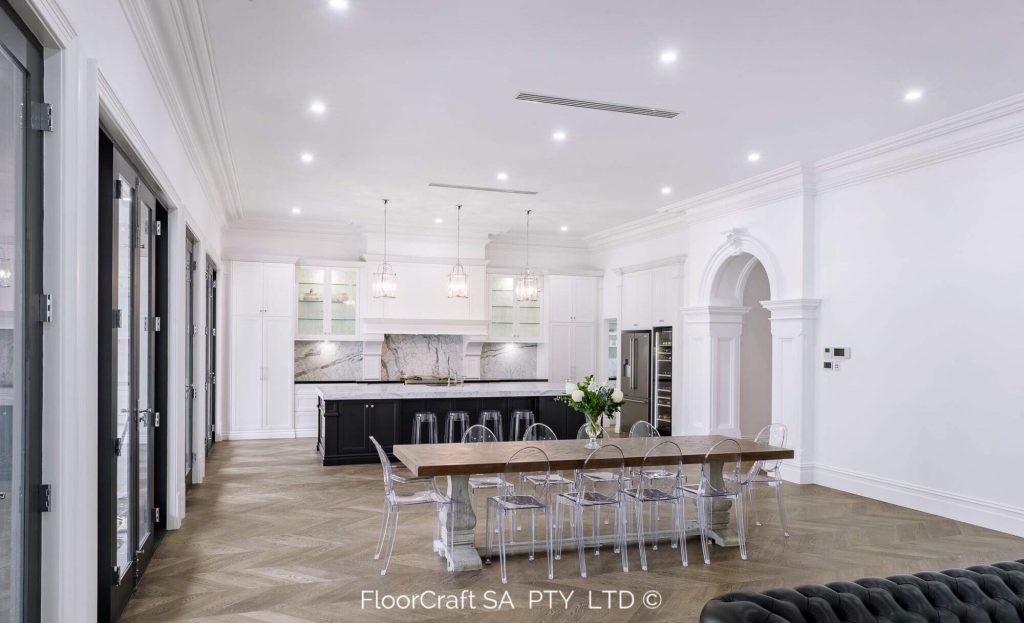Why timber flooring?
Timber flooring is practical, sophisticated and stunning solution for all of your flooring needs. It's cost effective with a solution for all budgets and styles. There are an a wide range of choices in species, colour variations and size.
Benefits of timber flooring including;
- A good solution for an allergy free home
- Extremely easy to clean and maintain
- The environmental choice - timber is one of the world's few truly renewable resources
- A long-lasting floor covering that can be refinished many times
- A timber sub-floor gives easy access to the underfloor for plumbing or ducted heating, or to repair wiring
- Insulation and warmth underneath feet unlike tiles
Things to consider when choosing a timber floor (tips when choosing a timber floor)
- Size
- Moisture content in timber
- Grades
- Colour variations
- Colour changes
- Movement
- Cupping
- Creaking
- Finishing
When considering timber flooring:
Size
Typically most hardwood flooring is available in many different widths and thicknesses. Many species can be obtained in thinner, wider or narrower sizes. Thinner boards are manufactured for direct stick method, whereas 19 mm or thicker boards are manufactured for installation over joists / battens.
Moisture Content of Timber
Timber flooring should be supplied with a moisture content between 9 and 14 percent. For most locations in Adelaide it is recommended that the moisture content of timber be between 10 and 12 percent. Under certain circumstances timber may need to be acclimatised to site conditions. Prefinished floors and laminates will not need to acclimate.
Grades
Most timber species are available in different grades. The grade of timber relates to the appearance of the natural characteristics of the wood, such as gum vein, insect holes, surface checks and other natural marks. It should be noted that as timber is a natural product even boards of the same species will differ in colour and markings. Select Grade is generally clearer of markings than Australiana grade, however, some gum vein, surface checks etc will still be evident. This grading is more suited to customers who require a more contemporary look.
- Australiana Grade: Particularly popular due to its rich appearance accentuated by more gum veins, spirals, shakes and marks left by forest insects. Australiana grade timber ensures no two pieces are the same providing a more natural look and feel to the floor.
- Natural Grade: For those who want a very rugged look to their floor, natural grade timber will provide all the natural markings but may also include some production faults such as holes, very large gum veins, miss milling etc. Natural Grade is not available in all timbers.
Colour Variations
Wood is a natural product, dependent on soil, climate, local environment and other natural occurrences for its colour and character. Colour variations should be expected and a part of the natural beauty of timber floors. The final colour or extremes of colour are often undiscernible until after the timber has been sanded and polished.
Colour changes
Timber will change its colour when exposed to natural light. You might find areas that are receiving more light will be darker or lighter than other areas.
Movement
As timber flooring is a Hygroscopic product (variable moisture content) it will move as it adapts to changes of humidity in its local atmosphere. In times of low humidity your boards will expel moisture and shrink, this may cause gaps to appear in the floor, however in times of high humidity the floor will expand, and gaps may close. FloorCraft allows for the natural movement of floors and will install your flooring in accordance with location and natural moisture levels.
Cupping
Cupping can be described as a “dish-like” effect resulting when the top of the boards become drier than the bottom of the boards. When timber loses moisture, it shrinks and when it picks up moisture it expands. Possible causes are:
- Dampness under the floor causing the bottom of the boards to pick up moisture faster than it can be expelled.
- An onset of very dry weather (low humidity), air conditioners or heaters drying out the timber from the top or sunlight through a window which may also dry out the top of the boards.
- The wider the board the more exaggerated the cupping can appear. It is a good idea to run the timber towards the main light source to minimise the visual effect of cupping.
Note: Do not automatically sand a floor flat to remove cupping. Preferably address the cause but if it cannot be fixed then wait for 12 -18 months and see if the cupping dissipates. If not, then you may possibly sand the floor flat. If you sand too early and the cause is later resolved you may experience reverse cupping.
Creaking
Most timber floors will make a creaking noise from time to time. It will usually happen after extreme weather changes or if a floor has not been walked on for some time. A new floor will make a creaking sound until it has “settled”. If the floor consistently creaks in a particular area it may need attention.
Finishing
FloorCraft use and recommend the use of water-based polyurethanes and oil based sealers for new floors. We do not recommend the use of Solvent based polyurethane or other products that may cause edge bonding. As timber flooring continues to move throughout its life due to changes in atmospheric conditions, we advise the use of products that allow the boards to move independently of each other.
Oil based sealers, modified oils and some water-based polyurethanes will allow free movement of the boards whereas solvent based polyurethane often bonds the edges of the boards together which may result in 4 or 5 boards being glued tightly together and excessive gaps appearing on either side of those boards.
